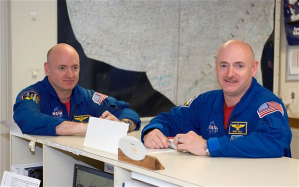Identical twins will be separated when one heads to space, as NASA conducts tests to see the impact of space travel on the human body, in an experiment reminscient of Einstein’s “twin paradox” theory

NASA is to send an identical twin to space, whilst leaving their twin on earth, to see the effects of long-term space flight on the human body. The experiment harkens back to Einstein’s “twin theory” paradox thought experiment – where one twin goes to space high speed, while their twin remains on earth. Einstein’s theory of relativity means that the twin will return from space younger than his brother. However, as it is impossible to study the flow of time, in this experiment, NASA will instead be testing 10 research proposals to study the twins’ genetics, biochemistry, vision, cognition. NASA astronaut Scott Kelly will go on a one-year mission to the International Space Station, while his twin, Mark – who is a retired astronaut – remains on earth. Craig Kundrot of NASA’s Human Research Program at the Johnson Space Center, said: “We will be taking samples and making measurements of the twins before, during, and after the one-year mission. “For the first time, we’ll be able two individuals who are genetically identical. “Each proposal is fascinating and could be a feature-length story of its own. “We already know that the human immune system changes in space. It’s not as strong as it is on the ground. “In one of the experiments, Mark and Scott will be given identical flu vaccines, and we will study how their immune systems react.” Other tests will examine DNA ageing, the effects of space travel on vision, and the stomach’s inner bacteria. The experiment will be conducted in March 2015.
Can you please explain why time goes by quicker in space that on earth? When Einstein says that “Measurements of various quantities are relative to the velocities of observers. In particular, space contracts and time dilates. The theory also adds: space and time should be considered together and in relation to each other. “The speed of light is nonetheless invariant, the same for all observers.” When he says that space contracts and time dilates, is he referring to the forces of gravity in particular? Also, what does the concept of ‘light in a vacuum’ mean, when referring to light years?
Time does not go quicker in space. Time slows down under the effect of gravity and it slows down when one moves at the speed up to that of speed of light.
General Theory of Relativity predicts Time and Space to be like a Fabric together(Space-time Fabric) and Gravity warps this fabric.
A light year is the distance traveled by light in an year.Speed of light varies with medium…Speed of light in vacuum is Three Hundred Thousand Km/sec. . Therefore the distance traveled by light at this speed in an year is a light year.
What do you mean when you say “and Gravity warps this fabric (time and space)”?
Also, what do you mean with: “Speed of light varies with medium”?
Gravity dents this fabric….this consideration is only for general understanding. Gravity slows down time…the stronger the gravitational field…the slower the time will go. Regarding space….its a touch hard for me to explain…m.sure i ll come up with something a lil later.Now regarding the speed of light…it varies with medium…light travels slower in denser mediums….for example glass or water….for air…speed of light is equal to that of speed in vaccum
It’s that ‘speed on vacuum’ that’s so interesting. What do you mean by vacuum?
vaccum is the spcae absent of matter…